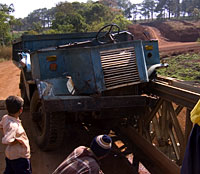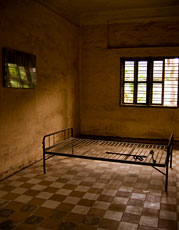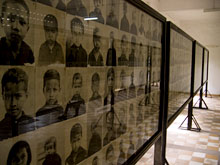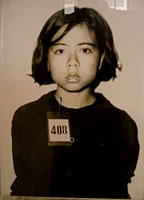Blood on the Tracks
It was a fittingly dull grey overcast sky, remnants of the previous night’s thunderstorm which kept me up for an hour or more while I sat on the spare bed beneath the window watching the room light up like a dance floor under a strobe, it had stopped raining, but it was still cloudy when I climbed on the back of a moto and headed out to the killing fields.
The killing fields outside of Phnom Penh are in fact just that, fields with depressions, large holes in the ground, some marked with staggering numbers, others with no sign at all. The Khmer Rouge slaughtered over 12,000 people at this site alone. It did not rain any more that morning but the sky remained dark and the holes were partially filled with water.
As I mentioned in the last entry I came down with a bit of a fever for a few days. This was accompanied by what we in the group have come to term, for lack of a nicer, but equally descriptive term—pissing out the ass. Yes it’s not a pretty picture. Nor is it a pleasant experience, but we have all done it, it was simply my turn. Consequently I don’t have a real clear recollection of the journey from Ban Lung to Kratie, nor do I have all that great of a recall from Kratie out to Sen Monoron. I do however remember near the end of the journey to Sen Monoron, as I sat in the cab of a Toyota pickup with ass cheeks clenched and stomach rumbling ominously, we came upon an accident blocking a bridge. A large transport truck had rammed into the side of a bridge and apparently been abandoned.  The result was a heavily loaded Toyota pickup nearly turned on its side in the middle of a small riverbed. Luckily the villagers in attendance seemed to have sensed our driver’s folly and were able to run in with various pieces of wood which they used to brace the truck and stop it from turning completely on its side. It took nearly an hour to get it unstuck and finally across the river. Rather frustratingly about three or four NGOs in their shiny new 4runners passed by without much trouble nor I might add offering much in the way of aid, despite what might have been stenciled on the side of their trucks.
The result was a heavily loaded Toyota pickup nearly turned on its side in the middle of a small riverbed. Luckily the villagers in attendance seemed to have sensed our driver’s folly and were able to run in with various pieces of wood which they used to brace the truck and stop it from turning completely on its side. It took nearly an hour to get it unstuck and finally across the river. Rather frustratingly about three or four NGOs in their shiny new 4runners passed by without much trouble nor I might add offering much in the way of aid, despite what might have been stenciled on the side of their trucks.
Matt has a fairly intense aversion to NGO’s which I am beginning to share, needless to say this experience did not help their cause in our eyes. The thing is we have traveled quite extensively in the backcountry of Laos and Cambodia and we have seen some pretty intense poverty. However we rarely see NGO groups out in these areas. We tend to find them near large resort towns like Luang Prabang or Seam Reap where air conditioning and western food is plentiful, or as we would witness down south, NGO’s seem to enjoy a bit of surf fishing from the comfort of their shiny 4x4s. So yes we have developed a healthy disrespect for those that claim to help, but spend their time close to the comforts of home. Lest we seem self righteous let me absolve a couple of spectacular NGO groups, the land mine people, that is, anyone clearing land mines and UXO, and the Friends organization in Phnom Penh which teaches street children how to cook and run restaurants. These two NGOs are superb and beyond reproach in all respects. However the vast majority of NGOs out here are, in the words of the English, a bunch of wankers.
Where for instance were the NGOs in 1974? Where was the west in general when Cambodia needed it? Where was the west when 3 million people were killed in less than four years? It’s easy to help when somebody else has solved the difficult problems (that would be the Vietnamese who, fed up with the Khmer Rouge, invaded Cambodia and drove the Khmer Rouge from power in 1979).
And just who were the Khmer Rouge? For those that don’t know here is the sound bite synopsis: in something like 1974 the US backed a military coup by a member of the Cambodian Army named Lol Nol. The coup disposed the King and sent him into exile. Just before he left he told the Cambodian people loyal to him to head to the hills and join the then fledgling Khmer Rouge. Lol Nol lasted some six months in power. The US backed him because he let them bomb the Viet Kong operating on Cambodia soil. Unfortunately he seems to have been quite corrupt and at the bare minimum was not popular. Roughly eight months later the US had lost the Vietnam War, pulled out of Southeast Asia and left behind a power vacuum (sound familiar?) which allowed the Khmer Rouge to step out of the jungle and into power.
In the beginning the Khmer Rouge were simply Cambodian nationalists who opposed Lol Nol, but by the time they seized power the Khmer Rouge had transformed themselves into something approaching Maoists. The Khmer Rouge’s goal was to an agrarian utopia in which all people were equal and worked the land. Unfortunately for the average person this meant the economy had to go. Money was abolished, the post service destroyed, and everyone was driven out of cities into the fields where they were worked to death. The Khmer Rouge set about destroying all literature, art, education, banned music, and basically took all the things that make life worth living and destroyed them. At some point a man whose name is undoubtedly familiar to most came to lead the Khmer Rouge, Brother Number One—Pol Pot. Under Pol Pot the killings escalated. Anyone educated was killed. Anyone literate was killed. Toward the end, anyone wearing glasses was killed. Those that survived did so by hiding and trying to blend in.
For the actual killings the Khmer Rouge favored lining people up in a field beside a large hole and then walking along behind them bashing in the back of their skulls with a blunt hammer. If you consider they killed three million people in four years you arrive at a figure of over 2000 people a day. The killing fields genocide museum outside Phnom Penh is not the only killing field. There is no “killing field,” there are thousands of them. Cambodia is covered in killing fields, the one outside of Phnom Penh is merely the one chosen to represent them all.
During this time the west did absolutely nothing.
The U.N. finally stopped recognizing the Khmer Rouge in 1991.
Imagine for a moment of the UN had recognized the Nazi Party as the rightful leader of Germany until 1957.
 I found it somewhat odd that although the bench and table were concrete they had been molded and painted to look as if they were wood. I thought for a while about the tree rings on display at Sequoia National Park in California where each ring is marked with a corresponding event from history. You can see how large the Sequoia was when Christ was born, when China built the great wall, when Columbus discovered America, and so on. The rings painted on the table before me were spaced rather widely such that as best I could count, given that I am not an expert at such things, the faux tree appeared to be roughly thirty years old, as if the artist may well have intended it to be a way to peer back in time, to create a point a singularity if you will from which all modern Cambodian history must come. The Khmer Rouge reset the calendar, calling the year of their rise to power year zero. The fake tree trunk before was, whether intentionally or not, painted to look as though it began life in that artificial year zero.
I found it somewhat odd that although the bench and table were concrete they had been molded and painted to look as if they were wood. I thought for a while about the tree rings on display at Sequoia National Park in California where each ring is marked with a corresponding event from history. You can see how large the Sequoia was when Christ was born, when China built the great wall, when Columbus discovered America, and so on. The rings painted on the table before me were spaced rather widely such that as best I could count, given that I am not an expert at such things, the faux tree appeared to be roughly thirty years old, as if the artist may well have intended it to be a way to peer back in time, to create a point a singularity if you will from which all modern Cambodian history must come. The Khmer Rouge reset the calendar, calling the year of their rise to power year zero. The fake tree trunk before was, whether intentionally or not, painted to look as though it began life in that artificial year zero.
After a while my moto driver saw me sitting there and wandered over, I was half expecting him to say it was time to go, but instead he sat down at the bench opposite me and crossed his legs. A very sad place no…? he said. I nodded but did not say anything. I was trying the judge his age. As best I could guess he would have probably been around eight when the Khmer Rouge took power. There is an entire generation missing in Cambodia, people of his generation are few and far between and most that you see are actually Vietnamese or Chinese emigres.
I was very young when this happened. He did not go on. I nodded and he smiled. He asked for a cigarette which I gave him. I worked in a field. From before dawn to after dark. I was seven. It was very hard. I got a fever and the Khmer Rouge gave us rabbit shit as pills because they could not afford medicine. My parents were dead already, but I had seen my mother boil the leaves of that tree and give them to my brother when he was sick. I looked behind me and he pointed, but I could not decipher which tree he meant. So I crush the leaves and made tea and I got better.
He did not say any more except to mention that it was time to go if I wanted to see the film at S21, which I did. I sat on the back of the moto as we headed into town wondering what I would do in the face of something like the Khmer Rouge. I decided that I would try to flee, but I’m not sure if that’s cowardly or not. If it was too late and I could not flee I do not know what I would do and I do not think anyone can know what they would do until they face such a situation.
 S21 is perhaps a little less known than the Killing Fields, owing no doubt to its lack of Hollywood endorsement, but S21 is even more chilling for the fact that it looks as if it were abandoned yesterday. Originally a school, the buildings became the central processing area for Khmer Rouge detainees, which is a sanitized way of saying it was a torture chamber. With the typical despots flair for brevity it was designated simply S21. Of the more than 17,000 people that passed through the walls and corridors of S21 under the Khmer Rouge, seven were alive when the Vietnamese liberated Phnom Penh. Other than scrubbing the stains from the walls and floors it seems as though very little had been done at S21. It looks like it might have been an active torture chamber a few hours before you arrived. The left hand building is a series of classrooms each totally bare save for a wire frame beds, a wrought iron bar and a car battery. These rooms served as torture chambers where prisoners’ were restrained while their fingernails were pulled out, their bodies electrocuted and battery acid poured on their skin. Standing alone in the bare rooms you can almost hear the screams.
S21 is perhaps a little less known than the Killing Fields, owing no doubt to its lack of Hollywood endorsement, but S21 is even more chilling for the fact that it looks as if it were abandoned yesterday. Originally a school, the buildings became the central processing area for Khmer Rouge detainees, which is a sanitized way of saying it was a torture chamber. With the typical despots flair for brevity it was designated simply S21. Of the more than 17,000 people that passed through the walls and corridors of S21 under the Khmer Rouge, seven were alive when the Vietnamese liberated Phnom Penh. Other than scrubbing the stains from the walls and floors it seems as though very little had been done at S21. It looks like it might have been an active torture chamber a few hours before you arrived. The left hand building is a series of classrooms each totally bare save for a wire frame beds, a wrought iron bar and a car battery. These rooms served as torture chambers where prisoners’ were restrained while their fingernails were pulled out, their bodies electrocuted and battery acid poured on their skin. Standing alone in the bare rooms you can almost hear the screams.
 The creepy thing about S21 is that the Khmer Rouge were methodical in their record keeping. Everyone who passed through S21 was photographed and a detailed biographical record was made. Some of these were lost, but the vast majority remain. Several halls of the museum are now simply rows and rows of black and white photographs of those who were tortured and killed at S21. I have not been to Auschwitz or for that matter any other genocide museum, but I cannot imagine a more stark and yet moving tribute to the victims than the bare walls and floors and endless rows of photographs.
The creepy thing about S21 is that the Khmer Rouge were methodical in their record keeping. Everyone who passed through S21 was photographed and a detailed biographical record was made. Some of these were lost, but the vast majority remain. Several halls of the museum are now simply rows and rows of black and white photographs of those who were tortured and killed at S21. I have not been to Auschwitz or for that matter any other genocide museum, but I cannot imagine a more stark and yet moving tribute to the victims than the bare walls and floors and endless rows of photographs.
 After touring the various rooms and halls of S21 I went up to the film room to watch a documentary film about the Khmer Rouge. The film itself was good, but in no way as moving as the simple existence of the place, which has a physical reality about it that is far more chilling than anything cinema is capable of. I found my mind wandering back to the same question I had been asking all day, How? How could the Khmer Rouge have happened? I’ve read a couple of books about life under the Khmer Rouge but I still can’t wrap my head around genocide, I just don’t understand how it happens, or how it can continue to happen. Like most people I want to know some reason, but it’s never that simple, there may not be a reason or even a collection of reasons that could explain the Khmer Rouge.
After touring the various rooms and halls of S21 I went up to the film room to watch a documentary film about the Khmer Rouge. The film itself was good, but in no way as moving as the simple existence of the place, which has a physical reality about it that is far more chilling than anything cinema is capable of. I found my mind wandering back to the same question I had been asking all day, How? How could the Khmer Rouge have happened? I’ve read a couple of books about life under the Khmer Rouge but I still can’t wrap my head around genocide, I just don’t understand how it happens, or how it can continue to happen. Like most people I want to know some reason, but it’s never that simple, there may not be a reason or even a collection of reasons that could explain the Khmer Rouge.
It would be nice to think the Khmer Rouge were just plain evil or crazy, but I don’t think it’s as simple as that. Pol Pot was educated in Paris, the head of S21 was a former professor of mathematics and the guards were hardened and formed just like the sadistic guards of the infamous Stanford Prison Experiment. Certainly these were not murderous simpletons on a rampage. The truth is there are a million tiny explanations, a million things that can add up to a genocide, but breaking them down and isolating them does not help to explain the overall phenomenon nor in my opinion does it help to prevent further genocides. I do not believe it is possible to stop wars. So long as there is a disparity of resources there will always be wars. And given that different climates are better and worse at generating resources there will probably always be a disparity of resources. But while it may not be possible to stop all wars, it may not be possible to stop all genocides, if we stop just one that would be a step in the right direction.
Thoughts?
Please leave a reply:
All comments are moderated, so you won’t see it right away. And please remember Kurt Vonnegut's rule: “god damn it, you’ve got to be kind.” You can use Markdown or HTML to format your comments. The allowed tags are
<b>, <i>, <em>, <strong>, <a>. To create a new paragraph hit return twice.